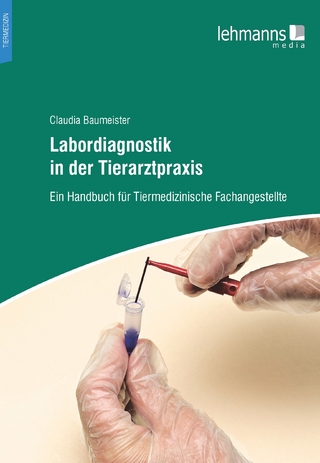Cooperative Veterinary Care
Wiley-Blackwell (Verlag)
978-1-119-13052-9 (ISBN)
- Titel ist leider vergriffen;
keine Neuauflage - Artikel merken
- Offers evidence-based cooperative techniques to prevent fear and calm reactive patients, with concrete guidance for preventing, identifying, and reversing fear and stress in the veterinary setting
- Provides a unique system for identifying patients and selecting the right technique for each pet
- Supplies information on safe patient exams and interactions without the need for restraint
- Covers strategies to successfully implement these new techniques every day and boost client compliance
- Presents step-by-step detailed training protocols, including photographs and over 100 videos showing how to train patients quickly and effectively
Alicea Howell, BS, RVT, VTS, KPA CTP, is a veterinary technician specialist in behavior at Hillview Veterinary Clinic in Franklin, Indiana, USA.
Monique Feyrecilde, BA, LVT, VTS, is a veterinary technician specialist in behavior. She is a full-time veterinary technician at Mercer Island Veterinary Clinic in Mercer Island, Washington, USA and owns a consulting business called Teaching Animals.
Acknowledgments ix
About the Companion Website xi
1 Introduction to Low -Restraint and No -Restraint Veterinary Care 1
1.1 First, Do No Harm 1
1.2 Stress, Fear, and the Veterinary Clinic 2
1.3 Freedom, Wants, and Needs 2
1.4 Iatrogenic Behavioral Injury 3
1.5 Introduction to Low - and No -Restraint Animal Care 4
References 9
2 Perception and Communication 11
2.1 Sensation and Perception 11
2.2 Stress and Fear 19
2.3 Body Language 21
2.4 Causes of Stress in the Veterinary Setting 40
References 44
3 Learning, Conditioning, and Training 45
3.1 Classical Conditioning 45
3.2 Operant Conditioning 49
3.3 Habituation, Sensitization, Desensitization, Counterconditioning, and More 58
3.4 The ABCs of Behavior 63
3.5 Fundamental Training Skills 67
References 87
4 Successful Visits: Environment and Protocols to Prevent Fear and Stress 89
4.1 Setting Up for Success: Before the Visit 89
4.2 During the Visit 91
4.3 Happy Visits and Other Preventative Planning 103
4.4 Hospitalization, Treatments, Diagnostics, and Boarding 108
References 119
5 Level One Patients and Training 121
5.1 Introduction to the Levels of Training 121
5.2 Identifying Level One Patients 121
5.3 Level One Training: Dog Exam Room and Examination 126
5.4 Level One Training: Cat Exam Room and Examination 132
5.5 Level One Training: Injections and Sample Collection 135
5.6 Administering Medications and Grooming 143
References 148
6 Level Two Patients and Training 149
6.1 Level Two Training 149
6.2 Identifying Level Two Patients 149
6.3 Level Two Training: Dog Exam Room and Examination 154
6.4 Level Two Training: Cat Exam Room and Examination 160
6.5 Level Two Training: Injections and Sample Collection 164
6.6 Administering Medications and Grooming 171
References 181
7 Level Three Patients and Training 183
7.1 Level Three Training 183
7.2 Identifying Level Three Patients 184
7.3 Preparing to Train 188
7.4 Making a Training Plan 190
7.5 Getting Started: Approach, Target, and Station 191
7.6 Teaching Consent, Touch, and Restraint 196
7.7 Muzzle Training 201
7.8 Physical Examination Training 202
7.9 Treatments, Sample Collection, and Imaging 207
7.10 Grooming 212
7.11 Additional Consent Options 216
7.12 Level Three Cats 218
8 Additional Patient Resources 223
8.1 Introduction 223
8.2 Neutraceuticals and Pharmaceuticals 223
8.3 Professionals and Their Roles 226
References 227
9 Implementation Strategies 229
9.1 Change Is Never Easy 229
9.2 Proposing Change 229
9.3 Overcoming Obstacles: Common Concerns and Questions 231
9.4 Making Change for the Right Reasons 237
Reference 238
Appendix 239
Glossary 241
Index 249
| Erscheinungsdatum | 16.04.2018 |
|---|---|
| Verlagsort | Hoboken |
| Sprache | englisch |
| Maße | 171 x 243 mm |
| Gewicht | 536 g |
| Einbandart | kartoniert |
| Themenwelt | Veterinärmedizin ► Allgemein ► Tiermedizinische Fachangestellte |
| Schlagworte | Tiermedizinische Fachangestellte |
| ISBN-10 | 1-119-13052-2 / 1119130522 |
| ISBN-13 | 978-1-119-13052-9 / 9781119130529 |
| Zustand | Neuware |
| Haben Sie eine Frage zum Produkt? |
aus dem Bereich





